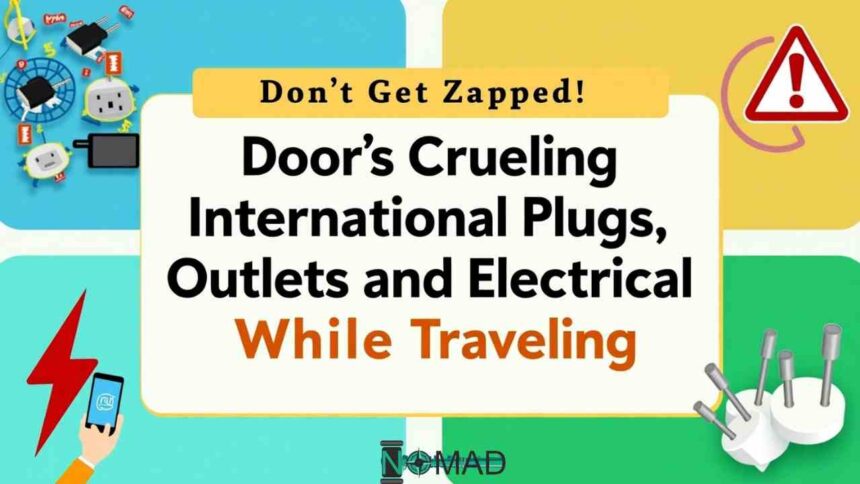Traveling internationally or moving abroad can be exciting, but dealing with different electrical systems is a common challenge. If you’ve ever arrived at a hotel only to realize your charger doesn’t fit the outlet, you know how frustrating this can be. Check out our guide below to get all the information you need about different plugs and outlets.
Different Plug Outlet Types
There are about 15 different types of plugs and outlets worldwide, labeled A through N. Here are some of the most common.
- Type A and B: Used in North America, Japan and parts of Central America. Type B has a grounding pin, while type A doesn’t.
- Type C, E and F: Found in most of Europe, South America and parts of Asia. Type C is the most common, with round prongs.
- Type G: Used in the United Kingdom, Ireland and several former British colonies, featuring three rectangular prongs.
- Type I: Found in Australia, New Zealand and China, featuring a unique slanted design.
The differences don’t stop there — South Africa, Brazil, India and many other countries have their own plug designs, as well. To avoid frustration when traveling, it’s crucial to research the most common plug type at your destination.
Voltage and Frequency Differences
Plug compatibility is only part of the equation. Electrical systems also have different voltages and frequencies. For example, North America operates on a 110-120V system with a frequency of 60Hz. In contrast, most of Europe, Asia, Africa and Australia use a higher voltage of 220-240V at 50Hz.
If you plug a 120V appliance into a 230V socket, you risk frying the device and causing an electrical hazard. Similarly, a device designed for 230V may not function properly in a lower voltage country without a converter.
Some electronics, such as phone chargers and laptops, are dual-voltage, meaning they can safely operate on both 110V and 240V. You can check whether your device is dual-voltage by looking at its label, which should read something like, “Input: 100-240V, 50-60Hz.” If your device supports this range, you’ll only need a plug adapter, not a voltage converter.
However, high-powered appliances such as hair dryers, curling irons and electric razors often don’t support dual voltage. These devices require a voltage converter to increase or decrease the power to match the local electric system. Using a converter ensures your device functions properly and prevents electrical damage.
Understanding voltage differences is crucial for protecting your devices, as well as for energy efficiency and sustainability. In the United States, over 40% of all energy consumption comes from building operations, including electrical equipment and appliances.
The way electricity is delivered and used can significantly impact overall energy efficiency, making it even more important to use the right electrical equipment both at home and abroad. To be even more energy-efficient, unplug devices and appliances when you’re not using them.
Adapters vs. Converters: What’s the Difference?
Many travelers assume a plug adapter is all they need, but there’s a key distinction between adapters and converters. A plug adapter simply allows your device’s plug to fit into a different type of socket. It doesn’t modify the electrical current or voltage. These are ideal for dual-voltage items like most laptops and phone chargers.
A voltage converter (or transformer) is necessary for devices that aren’t dual voltage. These devices require a change in the electrical output to match their specific voltage requirements.
Converters come in different wattage ratings, so it’s important to choose one that supports your device’s power requirements. Using the wrong converter can result in overheating, short-circuiting or permanent damage to your electronics.
Some modern travel adapters come with built-in voltage conversion, but they’re often not suitable for high-powered devices. If you plan to bring multiple electronics, investing in a universal adapter with multiple ports can be a convenient solution.
Tips for Traveling With Electronics
Traveling with electronics doesn’t have to be a hassle if you plan ahead. Here are some essential tips to keep your electronics working smoothly no matter where you go.
- Check your devices before you go.Look for voltage ratings on the charger or product label.
- Invest in a universal adapter that works in multiple countries. Avoid cheap adapters and converters. Low-quality ones may overheat or fail, putting your electronics at risk.
- Bring a power strip with multiple ports so you can charge numerous devices at once with one adapter. Use a voltage converter if needed for high-powered appliances like hair dryers or electric razors.
- Use a portable power bank to charge devices when power outlets are scarce.
- Consider a dual-voltage hair dryer or straightener. If you travel frequently, buying dual-voltage appliances is more convenient than carrying a bulky converter.
- Choose a hotel that practices proper safety measures. While an electrical hazard can happen anywhere, you can keep yourself protected by choosing a safe, well-reviewed hotel that prioritizes fire safety standards.
Stay Powered Anywhere
Understanding internal plugs, outlets and voltage differences is essential for keeping your devices safe and functional while driving. With the right adapters, converters and a little planning, you can avoid power issues no matter where you go. A bit of preparation goes a long way in ensuring a hassle-free experience with your electronics abroad.
Jack Shaw is the senior writer for Modded, a men’s lifestyle publication. An avid outdoorsman and lover of travel, he’ll often find himself taking retreats out into nature to explore the world and encourage others to do the same. Feel free to connect with him via LinkedIn.





